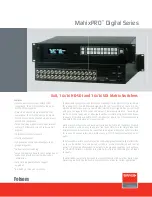
MSTP Overview
167
Determining an MSTI
In an MST region, MSTP generates different MSTIs for different VLANs according to
VLAN-to-spanning tree mappings. MSTP calculates each spanning tree independently
in the same way as STP/RSTP does.
Implementation of STP algorithm
In the beginning, each of the ports on each switch generate its own BPDU, taking the
switch as the root, setting the root path cost to 0, the ID of the designated bridge to
that of the switch, and the designated port to itself.
1
Each switch releases its BPDUs and operates as follows when receiving BPDUs of other
switches.
■
Discards the received BPDUs whose priorities are lower than that of its BPDU. That
is, the received messages of this type are not processed.
■
If the priority of a received BPDU is higher than that of the BPDU released by one
of its ports, the switch replaces the BPDU of the port with the received one and
compares the resulted BPDU with those of its other ports to obtain the one with
the highest priority.
2
BPDUs are compared based on the following principles:
■
The BPDU with a smaller root ID has a higher priority.
■
For BPDUs with the same root ID, the BPDU with a smaller sum of the root path
cost (in the BPDU) and the path cost of the port has a higher priority.
■
For BPDUs with the same root ID and root path cost, the designated bridge ID,
designated port ID, the ID of the port from which the BPDU is received are
compared in turn.
3
A spanning tree is figured out in the following steps:
■
Determine the root bridge
■
The root bridge is determined through BPDU comparing. The switch with the
smallest root ID is the root bridge.
■
Determine the root port
■
For each switch in a network, the port from which the BPDU with the highest
priority is received is set to be the root port of the switch.
■
Determine the designated port
First, a switch generates a designated port BPDU for each of its port based on the root
port BPDU and the root port path cost, setting the root ID to that of the root port
BPDU, the root path cost to the sum of the path cost of the root port BPDU and the
path cost of the root port, the ID of the designated bridge to that of the switch, and
the ID of the designated port to that of the port.
Then, the switch compares the resulted BPDUs with the original BPDUs of its ports.
For ports whose original BPDUs are better, the switch blocks them and remains their
original BPDUs, allowing them to receive BPDUs and forbidding them from
forwarding data. For a port whose original BPDU is not as good, the switch sets it to
the designated port, replaces the original BPDU with the calculated one, and releases
the new BPDU regularly.
Summary of Contents for 5500 SI - Switch - Stackable
Page 24: ...24 ABOUT THIS GUIDE...
Page 50: ...50 CHAPTER 1 GETTING STARTED...
Page 54: ...54 CHAPTER 2 ADDRESS MANAGEMENT CONFIGURATION...
Page 78: ...78 CHAPTER 3 PORT OPERATION...
Page 88: ...88 CHAPTER 4 XRN CONFIGURATION...
Page 122: ...122 CHAPTER 8 VLAN VPN CONFIGURATION...
Page 216: ...216 CHAPTER 15 SSH TERMINAL SERVICES...
Page 268: ...268 CHAPTER 16 IP ROUTING PROTOCOL OPERATION...
Page 308: ...308 CHAPTER 17 NETWORK PROTOCOL OPERATION...
Page 349: ...349...
Page 350: ...350 CHAPTER 18 MULTICAST PROTOCOL...
Page 522: ...522 CHAPTER 22 FILE SYSTEM MANAGEMENT...
Page 584: ...584 CHAPTER 30 PASSWORD CONTROL CONFIGURATION OPERATIONS...
Page 600: ...600 CHAPTER 31 MSDP CONFIGURATION...
Page 614: ...614 CHAPTER 32 CLUSTERING...
Page 670: ...670 CHAPTER C AUTHENTICATING THE SWITCH 5500 WITH CISCO SECURE ACS...
















































